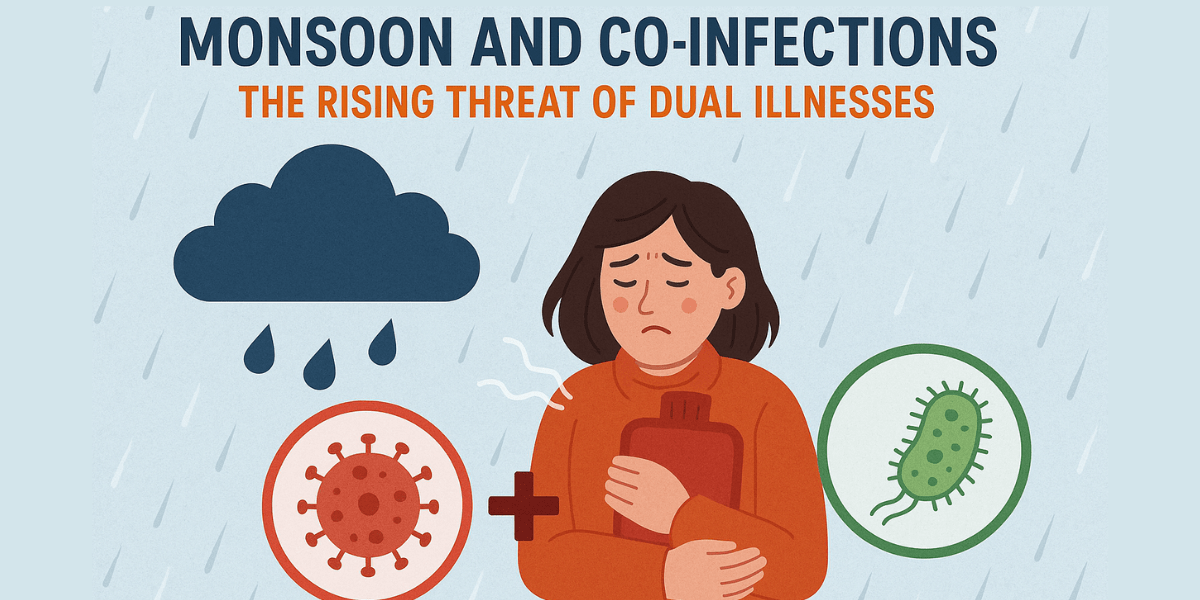
Monsoon and Co-Infections: The Rising Threat of Dual Illnesses
Every year, the arrival of the monsoon season brings relief from scorching summer heat, but it also opens the door to a host of health challenges. Stagnant water, rising humidity, and poor sanitation combine to create the perfect environment for infectious diseases to spread rapidly. While single illnesses such as dengue, malaria, or typhoid are already common during this season, a growing concern is the rising threat of co-infections during monsoon. These dual infections in the rainy season pose serious risks to patients, as they make recovery harder and increase the chances of life-threatening complications.
Understanding Co-Infections

A co-infection occurs when a person is infected with two or more pathogens at the same time. For example, someone battling dengue may simultaneously contract typhoid or a respiratory infection. Unlike single infections, co-infections weaken the immune system further, slow down healing, and complicate treatment. In recent years, doctors across South Asia have reported an increase in cases where patients suffer from multiple illnesses at once, particularly during the monsoon.
The rise in monsoon diseases and infections means that co-infections are no longer rare, they are becoming a dangerous trend that the healthcare system must be prepared to handle.
Common Monsoon Illnesses
Several common monsoon illnesses act as the building blocks for co-infections. These include:
-
Dengue fever – Spread by Aedes mosquitoes, causing high fever, body pain, and risk of bleeding.
-
Malaria – Another mosquito-borne infection, leading to cycles of fever, chills, and fatigue.
-
Typhoid fever – Transmitted through contaminated food and water, causing abdominal pain and prolonged fever.
-
Hepatitis A and E – Viral infections linked to unsafe drinking water.
-
Seasonal flu and respiratory infections – Triggered by high humidity and poor ventilation.
When these illnesses overlap, patients face dual infections in the rainy season, which complicates diagnosis since symptoms often mimic each other.
Rising Threat of Dual Infections
The rising threat of co-infections during monsoon is concerning because patients often struggle with delayed diagnosis. For example:
-
A patient suffering from dengue and typhoid may show overlapping fever and weakness, making it difficult for doctors to determine the correct treatment.
-
Co-infections of COVID-19 with influenza or pneumonia during monsoon have also been reported in recent years.
-
Cases of malaria with hepatitis are increasingly observed in flood-affected areas.
The danger lies in the fact that one infection weakens the immune system, making the body more vulnerable to another. This not only prolongs hospital stays but also increases mortality risk.
Health Risks of Co-Infections During Monsoon

The health risks of co-infections during monsoon are much more severe compared to single infections. Patients may experience:
-
Prolonged high fever and dehydration
-
Severe weakness and fatigue
-
Liver, kidney, or lung complications
-
Increased risk of bleeding and organ failure
-
Slower recovery due to overlapping treatments
Children, pregnant women, and individuals with chronic illnesses such as diabetes or hypertension are especially vulnerable. In such cases, early diagnosis and immediate access to medicines can make the difference between recovery and serious health outcomes.
Preventive Measures Against Dual Infections
Prevention remains the most effective strategy against co-infections. Individuals can reduce their risk by following monsoon preventive measures such as:
-
Drinking boiled or filtered water to prevent waterborne infections.
-
Using mosquito nets, repellents, and wearing full-sleeved clothing.
-
Avoiding street food and ensuring proper hygiene during meal preparation.
-
Keeping surroundings clean and ensuring there is no stagnant water near homes.
-
Getting timely vaccinations recommended for flu, hepatitis, and typhoid.
Public awareness about monsoon health and hygiene is critical in reducing disease spread. Communities must work together with local health authorities to control mosquito breeding and improve sanitation.
Role of Pharmacies in Fighting Co-Infections
Pharmacies play an essential role in supporting patients during the monsoon season. In cities like Karachi, where healthcare facilities are often overwhelmed during peak outbreaks, pharmacies ensure uninterrupted access to essential medicines, antibiotics, hydration salts, and preventive health products.
The best pharmacy in Karachi, Dawa Healthcare Pharmacy, has been instrumental in providing timely medicines and guidance to patients at risk of co-infections. As a certified pharmacy in Karachi, Dawa Healthcare ensures that all medicines are authentic, stored properly, and dispensed with expert advice.
In addition, pharmacies serve as the first point of contact for families dealing with fever, weakness, or dehydration. By guiding patients on safe use of antibiotics, hydration solutions, and over-the-counter remedies, pharmacies act as a bridge between communities and hospitals during seasonal outbreaks.
Conclusion
The monsoon diseases and infections we see every year are not just seasonal inconveniences—they can develop into life-threatening co-infections if not handled promptly. The rising threat of co-infections calls for greater awareness, preventive action, and access to reliable healthcare.
By practicing good hygiene, ensuring safe drinking water, and protecting against mosquito bites, individuals can reduce their risk. At the same time, having access to trustworthy healthcare providers is critical. Dawa Healthcare and Dawa Healthcare Pharmacy, recognized as the best pharmacy in Karachi and a certified pharmacy, continue to provide reliable medicines and expert guidance to help families navigate the dangers of dual infections in the rainy season.
With prevention, preparedness, and trusted healthcare support, communities can protect themselves from the growing risk of co-infections during monsoon and safeguard public health.

